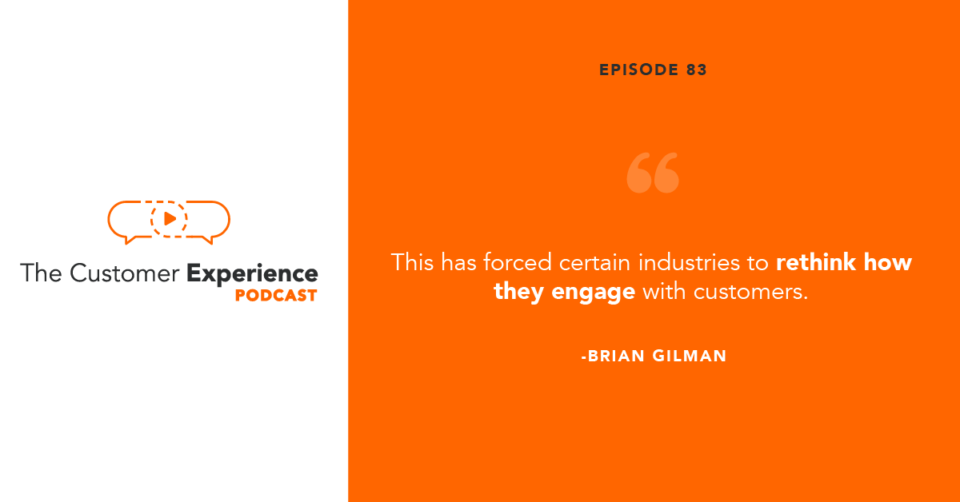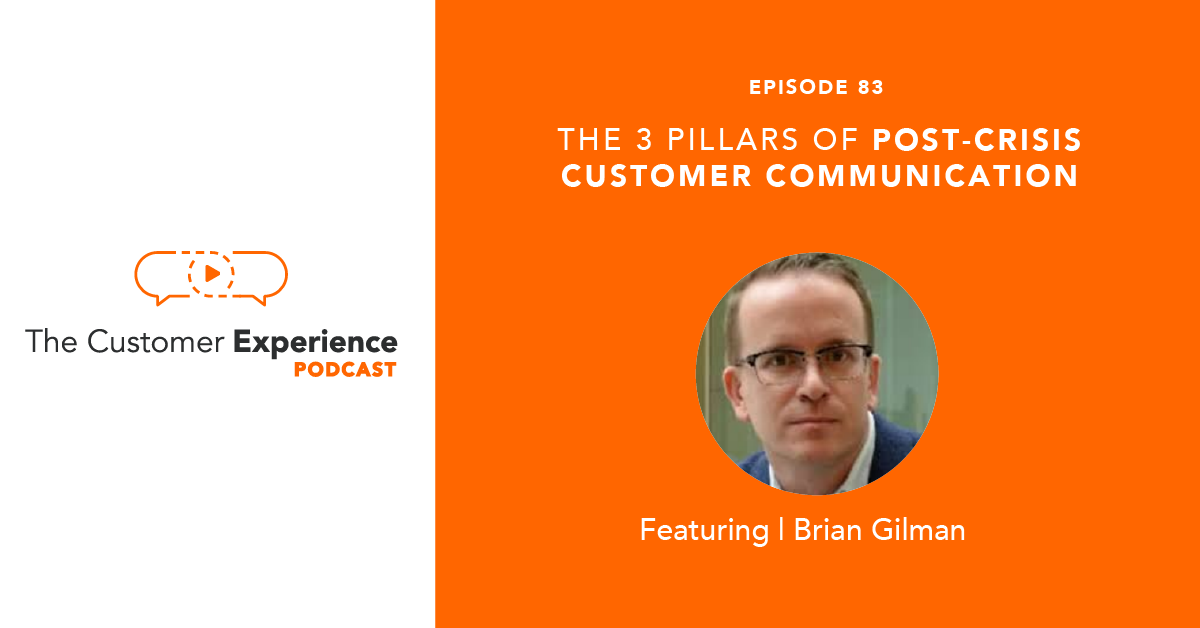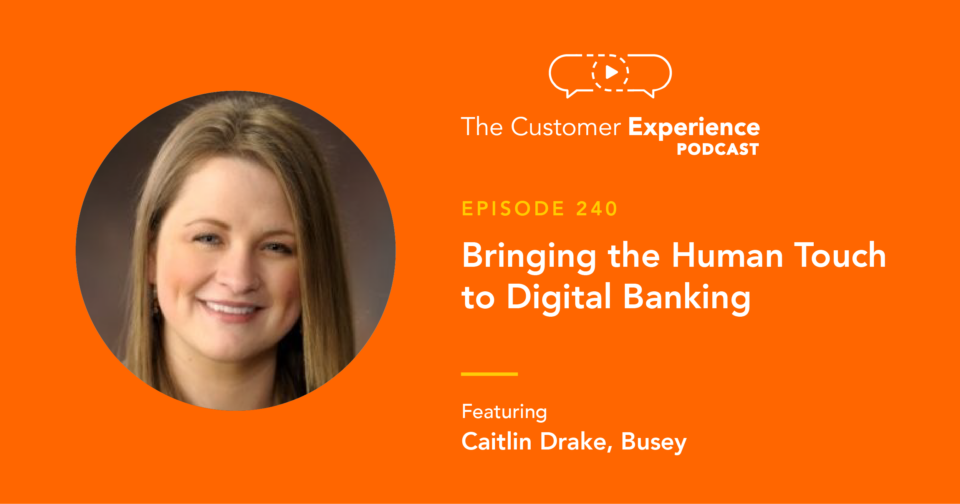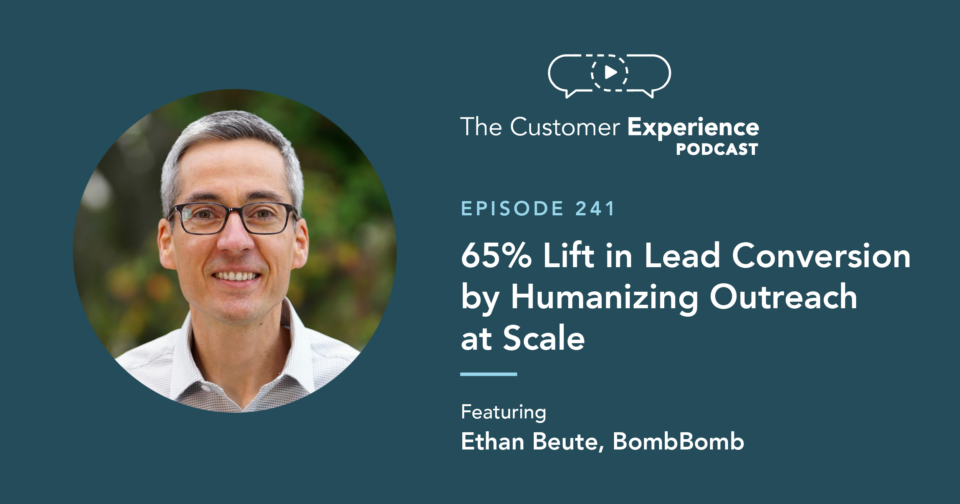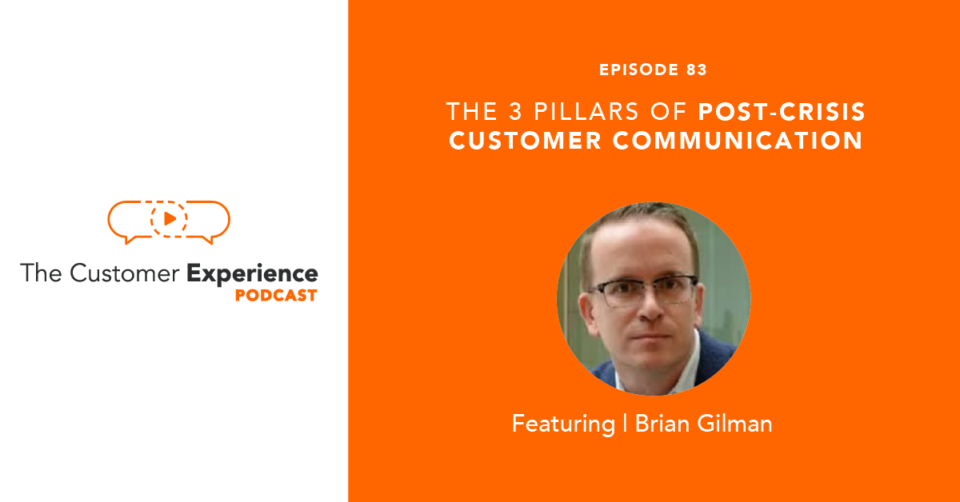
Listen to “83. The 3 Pillars of Post-Crisis Customer Communication w/ Brian Gilman” on Spreaker.
Apple Podcasts | Google Podcasts | Stitcher | Spotify
The impact of COVID-19 on businesses in evident – especially when it comes to how we communicate with customers. The numbers say it all: telehealth engagement increased by 700%. The consumer packaged goods industry saw call spikes of 56%. Banks saw a 44% bump. Normal is obviously long gone.
Though the pandemic remains, the initial crisis stages are as follows:
• Pre-Crisis: January-February 2020
• During-Crisis: February-May 2020
• Post-Crisis: June 2020-December 2021
Each one presented its own industry-shattering challenges. Now that we’re at the beginning of the post-crisis phase, we need to be focused on the systems we have in place to communicate with customers.
We need to ask ourselves, “How have our communication systems changed since the pandemic, and how must they evolve further to best serve our customers?“
Today’s (returning) guest on The Customer Experience Podcast, Brian Gilman, answers this question in this episode. He addresses how to create a frictionless customer experience in the post-crisis pandemic stage.
Brian joins us again, this time to focus exclusively on opportunities for companies to re-envision themselves and rethink how they can expand their channel and engage with customers in all-new ways.
Brian currently serves as Vice President of Solutions Marketing at Vonage, the world’s most flexible cloud communications platform. His insights into crisis communications across industries will give organizations purpose for the ups and downs of our post-crisis era.
In this episode, you’ll hear about communication from a cloud solutions perspective. We talk about:
• What Pre-Crisis customer communication looked like
• How customer conversations changed in the During-Crisis phase
• Why replacement for work from home, failover and contiunity, and augmentation are three pillars most organizations need
• How the pandemic has forever transformed how certain industries communicate with customers
• What CX opportunities stem from the Post-Crisis reality we’re living in
The 3 Pillars of Post-Crisis Customer Communication
Hear the entire conversation with Brian Gilman on post-crisis communication right here:
Listen to “83. The 3 Pillars of Post-Crisis Customer Communication w/ Brian Gilman” on Spreaker.
Hear this episode of The Customer Experience Podcast – and many others – by subscribing to in:
While you’re at your preferred player, please take a minute to subscribe and to provide a rating or review. A minute of your time really helps other people find and evaluate the show.
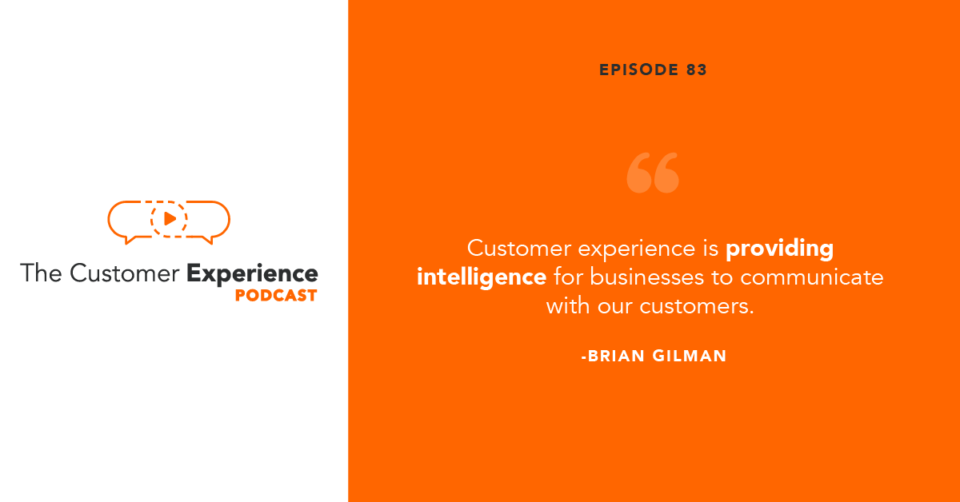
Full Transcript: The 3 Pillars of Post-Crisis Customer Communication
Ethan Beute:
The doors shut on the economy in about 48 hours, but it’s going to reopen into some kind of new normal over 18 to 24 months. The circumstances priorities opportunities to redefine winners and losers in terms of customer experience, so we should rethink right now what we’re doing to prepare for whatever a new normal looks like, whenever it arrives. Today’s guest was featured in episode 25 of the Customer Experience Podcast. That one was titled Why Friction is a Customer Experience Killer. He’s back to talk through three distinct periods of time, pre-crisis, the past few months, and post-crisis.
Ethan Beute:
He’s served in leadership roles in services marketing, product marketing, and solutions marketing with several leading communications companies like Avaya and Polycom. He currently serves as vice president of solutions marketing at Vonage, the world’s most flexible cloud communications platform. Brian Gilman, welcome back to the Customer Experience Podcast.
Brian Gilman:
Thanks for having me, Ethan. I’m sporting my quarantine cut, so I feel a little bit different than last time.
Ethan Beute:
Good, yeah, and you’re looking really tight there. For folks who haven’t done this before, you can go to BombBomb.com/podcast, and we include some video clips from these conversations if you want to check out that really tight quarantine haircut. I guess let’s start there for a minute. Reporting here in late May 2020, you’re in New Jersey. What’s the scene there for you and your family, maybe your team members, and maybe your customers at a high level? What’s going on?
Brian Gilman:
Yeah, I am now in what was one of the two hotbeds in North America. I’m in New Jersey. I think New Jersey as a whole, because of its proximity to New York City and the amount of people that go into New York City, became really a hotbed for the spread of the virus. Thankfully, I live west, grew up fairly far west from the city. It’s not a very populated area. The town I live in is not bad, but when you look at New Jersey as a whole working at Vonage, we got an email on a Tuesday afternoon essentially saying we were closing our doors down on Friday.
Brian Gilman:
Packed up our laptops and haven’t been back, and now we’re in our weekly meetings with executive management, trying to figure out when are we reopening? How are we going to reopen? What is our new normal going to look like? It’s been an interesting couple of months. Some of our offices overseas have already started to reopen slowly. I think it’s something to your point. I think we will feel this out over the course of a pretty long period of time. I don’t think we’re going to just reopen fast as we closed the doors.
Ethan Beute:
Yeah, definitely not. We did the same thing. We had been talking as an executive leadership team at BombBomb about what we were going to do, and then all of a sudden one of our two co-founders was like, “We’re out. Shut it down. Everyone go home.” It was just super fast. It’s interesting. I had the foresight, because I was in a lot of those conversations, to start moving some stuff out of my office into my home. It’s interesting. Some people didn’t feel like they maybe had permission to double back and grab some things that they would need.
Ethan Beute:
I don’t know that anyone expected it to go this long out of the gate. When that thing happened, you figured like, “Okay, it’s going to be a month. I’ll just make it work for now.” Then here we are settling in and like, “Maybe I should double back and pick up some new items.”
Brian Gilman:
Yeah, no, it’s really funny because as this hit and we were just discussing it earlier, I think that employees, and more importantly companies’ perspective on work from home, and even terms like business continuity have been completely redefined by this pandemic. One of the topics I have to talk a lot about recently has been this concept of business continuity. I think when you talk about my days back at Avaya, I remember being conversations we had around business continuity was, “Well, what happens if a backhoe cuts the fiber line outside of our business, and we’re offline for a couple days?”
Brian Gilman:
No one ever had to think through what happens if we have a global pandemic, and we’re all out of the office for several months? What is the impact on our employees that are agents, and then our impact to our external customers? It’s a wild ride, and it’s really redefined everybody’s thoughts on work from home, business continuity, fail-over. We’ve seen years worth of transformation take place in only a matter of months.
Ethan Beute:
Yeah, I’m looking forward to getting into that conversation deeper, but let’s start where we always start, which is your thoughts or characteristics, definition. When I say customer experience, Brian, what does that mean to you?
Brian Gilman:
For me, customer experience is really providing a level of intelligence for businesses to communicate with their customers. I always take it back to the airline experience of yesteryear, when you called to book a ticket, and you verify yourself with your social security number, your mother’s maiden name, you give them the birthrights to your firstborn, and then where you get that one agent, and they go, “Oh, you want an international flight. Let me give you over to the international department.”
Brian Gilman:
What’s the first thing they ask you? “What’s your name?” Then you to re-up on all of those. To me, customer experience is about creating simplicity and seamlessness between interactions. I think over the past two to three years, I would say, more so than at any other point in time in my career, the customer interaction has changed in terms of how they want to interact with businesses, with that be social, SMS, video. It changed so dramatically, and it’s no longer being driven by the business. It’s being driven by the consumer and how they want to interact with the business.
Brian Gilman:
For me, customer experience is meeting the consumer at their preferred channel and making sure that you have that same level of seamlessness regardless of whether it’s new to the business or not.
Ethan Beute:
Really good. If folks want to go deeper into that conversation, we spent a lot of time talking about, and you can see how the title was Friction is the Customer Experience Killer, consumer choice, channel choice, the shift of control. Those are all themes on episode 25. Before we go farther here, Brian, into the three phases in what you’ve observed and what you’re learning, for folks who aren’t familiar with Vonage, who is your ideal customer, and what do you sell for them?
Brian Gilman:
Sure. Vonage is a global leader in cloud communications. We have unified communications and…solutions, in addition to communications APIs. We own and control our whole communications stack, whether it be the PBX for employee communications, the contact center, or APIs to enable those embedded experiences in your mobile and web devices. We power some of the largest brands in the world in terms of connecting customers to the businesses that they interact with.
Ethan Beute:
Awesome. Let’s go pre-crisis. Now we’re just going back a few months.
Brian Gilman:
You mean the end of 2019? It seems like forever.
Ethan Beute:
Yeah. How do you think about this pre-crisis phase and where we were with regard to some of these themes we were talking about, including continuity, cloud, et cetera?
Brian Gilman:
Yeah. When I look back to end of ’19, maybe January of ’20, a lot of the discussions around communications were have traditional motherhood and apple pie. How do I go from CAPEX to OPEX? How do I eliminate a single point of fail-over with my PBD? Oh, yeah, how do I solve for omnichannel customer challenges? How do I integrate into my CRM to make sure that I’m getting screen pops and the appropriate call routing? It was a very technical conversations of replacing the on-prem and moving to the cloud and trying to drive efficiency and productivity measures.
Brian Gilman:
It was still very rudimentary in terms of solving for those unique challenges because it was agent productivity, it was customer interaction, but it was still rooted in the fundamentals of what the cloud was, and the benefits that the cloud brought, barely all changed. Yeah, you get into the here and now, but that was what it was back then. It was how do we solve for what seemed to be really easy topics back in the day?
Ethan Beute:
How is that going for you and for your team, and to the degree that you have direct customer interaction, what was the nature of that?
Brian Gilman:
At the time, pre-crisis, the cloud had been the norm in terms of… I think communications were at the lower ends of the market, and moving very fast to the cloud at the upper end of the market, where there’s a little more hesitancy around security, compliance, all of those things. Even that, when you look at the largest global organizations in the world, a lot of their data sits in the cloud. While some companies were reluctant to move to the cloud for their communications, it was happening very quickly, especially when you started to look at larger businesses who are starting to use APIs to communicate.
Brian Gilman:
It was, how do we tie our communications experience on the API side with our cloud communications in a compact…side? It was happening. We still were dealing with certain challenges that were more industry-specific, and they were more workflow specific, and the cloud had become the norm in terms of… You look at the largest communications companies today. They’re all in the cloud. That’s where all the valuation sits. That’s where everyone is looking to move.
Brian Gilman:
It’s no longer predicated in landlines and ye old telco methodology.
Ethan Beute:
Yeah, it’s obviously cost savings, probably some savings with regard to on-site IT, and that type of thing.
Brian Gilman:
Exactly.
Ethan Beute:
It’s reassigning some of the trouble to the provider.
Brian Gilman:
And future-proofing. Don’t forget future-proofing. That’s the one that everyone loves… Everyone loves to associate the cloud with future-proofing, but it is. It’s that IT administration. Its cost where you’re no longer having to put down for a $1 million PBX, or a $1 million contact center, but you’re paying for seat. In other words, there was financial benefits, but no one was really looking towards what we just ran into. That brick wall.
Ethan Beute:
Yeah. We’re going to go to probably February, March in just a sec, but for folks who aren’t familiar, what is PBX?
Brian Gilman:
PBX is the old pre-unified communications. It was the on-prem call control for your business phone system.
Ethan Beute:
Got it. Take us into I guess probably mid- to late February. What were the early signs that there as going to be a big shift coming for Vonage and Vonage customers? We talked about the executive leadership team. Did it start in that conversation, or was it, “Customers are starting to ask about this, how seriously should we take it?” What was the scene in probably mid-Feb?
Brian Gilman:
It’s weird because you talk about early signs. There wasn’t really early signs. To your point, I don’t think anyone thought it was going to go the road that it went. When all of a sudden states starting shutting… We were in our normal sales cycle with customers. Customers were looking to move to the cloud, and then all the sudden states starting shutting down. All of a sudden the tone of the conversation was changing. It wasn’t so much about digital transformation.
Brian Gilman:
It wasn’t about, “Help me migrate from where I’m at to where I want to be.” It wasn’t about future-proofing anymore. It was, “Oh, my God, I have to close my contact center in four days. What can you do?” The discussions became less around digital transformation, and I don’t mean to use this term loosely, but it was, “Help me bubble gum and duct tape something,” because the level of urgency and panic now took place. I’m in an on-prem environment. I have to move 6,000 employees. I have to move 500 agents off-site.
Brian Gilman:
I’m in an on-prem solution, and I don’t have the ability for them to communicate. All of a sudden inbound call traffic dies. What happens now? You want to talk about bad customer experience, there it is when all of a sudden you make a phone call and no one picks up, or get a message which says, “Due to a global crisis, we don’t have anyone to take your call. Sorry,” and you get a hangup. That was happening all of a sudden. The conversations were as fast as Vonage shut its doors from Tuesday to Friday, customers were coming to us saying, “What can you do to keep us up and running?”
Brian Gilman:
The cloud now became… You had customers saying, “We want to rip and replace. We were already discussing it. We’re ready to move.” Then it was, “I can’t move. I’m afraid to move. What I have works, but can you do something to help me mitigate?” That was where I think all of a sudden the industry changed overnight. It was, how can the cloud now provide a solution to 6,000 employees? Rather than replacing the PBX with a cloud PBX, it was we’ll enable a number of mobile licenses. We’re not going to port your numbers anymore.
Brian Gilman:
You’re going to keep your same business line. You’re going to forward your business line to your new cloud number. There’s seamlessness in that call. Now when your phone rings, your mobile rings at home on your desktop or your mobile phone. You have continuity of service. For us, that’s a great scenario because not only are we replacing the phone number, but we’re giving these customers the best try and buy in the world, because not only is dial tone replaced in it, but they now have video collaboration, team messages, all those things that you get with a unified communications solution.
Brian Gilman:
In the contact center, a lot of the same things were taking place. “Help me failover from my on-prem contact center to a cloud-based solution so that I can at least maintain some form of loose voice call routing, call traffic, call queuing, et cetera.” For us, it ended up being a very good scenario in the UC and in the contact center space, albeit you weren’t getting the big transformational deals. You were now helping customers, so this part of this was philanthropic. It was how can we help customers better?
Brian Gilman:
Where we saw a dramatic change was industry changes like you think about healthcare. What are we all hearing about now? You can’t go five seconds without seeing an article or a news piece on telehealth. The API business shot like a rocket. While we were a global leader in telehealth, we were seeing traffic on our network go up 700% for telehealth engagement. We were a leader in the space so that 700% wasn’t a small number going to a relatively huge number. It was a large number going to a catastrophically large number.
Brian Gilman:
Now you’re seeing changes that were taking place slowly over time now all of a sudden becoming the new normal. That is where I think the market is seeing tremendous shifts. I did a webinar for our company last week, and one of the quotes that I had found was large US banks, the largest of the banks, were seeing call spikes of 44%. The consumer packaged goods industry were seeing call spikes during the week, 56%. The world can’t flip like that.
Brian Gilman:
Even for companies that were in the cloud, and so… Forget the worst-case scenario. I’m in an on-prem environment. I need to find a way to make things work. I’m in a cloud environment. I can’t handle a call volume spike of 56%. I can’t throw enough agents at it. The third pillar that I think has dramatically changed was this whole concept of help me augment what I already have to make it more efficient or more productive.
Brian Gilman:
Things like AI came into play, where we can now insert virtual assistance to help with those customers that needed to self-serve. Help me track my package that isn’t showing up at my door anytime soon. Help me check my checking account balance to make sure that I still have money in the account. Those can now be offset without that agent interact to help grease the skids a little bit and keep things moving. That’s really where the market has now changed.
Brian Gilman:
It’s now not only replacement for work from home. It’s not only fail-over and continuity, but it’s this augmentation piece that we’re now helping solve for, and that has really changed the market dramatically because it’s not something that is easily done, whether you’re on-prem or in the cloud.
Ethan Beute:
Talk about, just go back maybe three to five minutes here where you have someone that’s maybe been on the fence for a while. They’ve been evaluating some of the benefits, they’re probably sitting with a little bit of chronic pain because they fear the acute pain of the switchover, whatever, and now they’re forced to rip off the bandaid, or make the commitment, or make the jump, the leap, the whatever. How did your team, to the degree that you’re able to describe it, how was your team able to… ?
Ethan Beute:
I’m assuming there were a number of companies that were in these various situations. How were you able to A, reorg workflows internally to help convert all of these clients in this really tight window while you’re going through the transition yourself? Maybe to the degree possible, go into the depth of all of these call center workers that are now being sent home are on a new system, they have new workflows. How do you get those folks trained up? So much had to happen in such a short amount of time internally on your side, at the decision-making side, at the high-level adoption side, and then all the way down to the front lines of your customers.
Ethan Beute:
What are a couple tips maybe that you’ve picked up or observations around making that many changes in that short amount of time under these stressful situations?
Brian Gilman:
Yeah. Yeah. Okay, there’s a lot to unpack there. Internally as a business for us, for our contact center, because clearly we had to deal with this. We’re on the front lines of this, as well. For us, it was relatively easy because we’re our own best customer. We got the email, and for us it was like, “All right, I pack up my laptop, I go home.” I don’t even have a desktop phone in the office. I use my mobile client on my cell phone because I’m never at my desk.
Brian Gilman:
I’m usually in a conference room somewhere, so if someone wants to reach me, I get a call on my cell phone and I decide whether or not I’m going to take it depending on the meeting that I’m in. For us, it was relatively easy. The adjustment that started to take place, though, was when your sales notion becomes more of a consultative approach, where you’re having to solve for different challenges where things aren’t being ripped and replaced, necessarily, but we’re having to play as a fallback for an existing solution.
Brian Gilman:
That’s where our sales teams, while we have always had the role of somewhat consultants, I think the sales cycle for what has been challenging… You needed a longer time to go and have these complicated solutions, and you have two days to figure it out. It’s worst-case scenario. My apologies for the leaf blower in the background. You’re being forced to have what would be an extended sales cycle take place in 24 hours. From our sales team’s perspective, they were monumentally helpful in identifying solutions.
Brian Gilman:
As we were building out… We were custom building IVR solutions for food banks, for COVID testing centers where they needed systems up in 24 hours. We had systems engineers that were helping figure those complex solutions out, and getting them spun up in 24 hours, building them in sandboxes with our APIs, sending them out to these organizations quickly. What then has to take place is, a lot of these are complex. For these tens of thousands of contact centers that we were helping to failover in a short period of time, a lot of that wasn’t as complex as it sounds, because we weren’t… Out an existing solution.
Brian Gilman:
We weren’t having to port over new numbers. It was getting the customer comfortable with the fact that you’re keeping what you have. We’re going to overlay you with new employee phone numbers, new agent numbers, and we will forward those numbers. From an ease of use, it wasn’t incredibly complicated. The hard work was taking place on some of these one-off, help me spin up a complex call routing tree for a COVID testing center. We have some of the best systems engineers in the world. They were doing this overnight, and we were talking on philanthropic efforts to go and stand up some of these customers very quickly.
Brian Gilman:
Like I said, some of it was becoming more of an advisor or a member to these customers to get them comfortable with what you’re doing. For some of these others where it was, “Can you help me stand up something with no infrastructure?” Those were almost the easier discussions to have because we could hand those off to some of our SCs, they would take a look at it and go, “We could have this set up in 48 hours for you.”
Brian Gilman:
Best practices fly out the window a little bit in these environments, because you have some teams that are rushing in and solving for some of these complex issues overnight, and then in the other hand you have our sales teams that are having to do things very quickly, but they’re not necessarily ripping and replacing. Those ripping and replacing discussions have now, now that we’re… This all took place in a matter of 30 to 45 days, where you had companies that were in the throes of what they needed to do.
Brian Gilman:
Now we’re in this place of whether or not we did something immediately, they either stuck with what they had… There are some companies that couldn’t make the change, and they’re like, “Use your cell phones,” which is horrible beyond belief, but it works for them. Their percent of where they needed to be, their employees are kind of productive, they figuring ways out through third-party, over-the-top solutions. Not elegant. They’re now coming to say, “We’re through the…How do we start to plan now for the next?”
Brian Gilman:
I think that’s the real important thing. Now that we’re out of that conversation to started to normalize, where it’s, “We need to accelerate our thoughts around the cloud. We thought we were going to keep what we had for another six months or a year. That’s clearly not going to happen. How do we get out of this before the next whatever comes down the road?” Which I think is what everyone is now starting to think. Things that were… We knew the cloud adoption was going to accelerate.
Brian Gilman:
It’s accelerating now because we don’t want to get stuck in a second way of contact centers having other figure out fail-over methodology. The conversations are happening a lot faster.
Ethan Beute:
Yeah, I feel like you really teed us up there for the third phase here, which is you’re doing some cleanup now, which is people who came up with their own bubblegum and bandaid and duct tape solutions, and now they’re saying, “Okay, we weathered the initial part of the storm. Now let’s figure out how to prepare for the next phase, or the next incident, or where we know we need to be now that we’ve suffered this experience as an organization, and probably let some of our customers down in the process.”
Ethan Beute:
Talk a little bit about the conversations you’re having about the post-crisis period, like the timeline, what it might look and feel like, and maybe where we’re headed just assuming that the vast majority of companies will have successfully migrated a lot of their operations and communications, and other processes into the cloud. What does it look like 12, 24 months from now?
Brian Gilman:
Yeah. This is the main reason why I reached out to you. What we have now seen is not only companies having to scramble to figure this out. That’s one piece of the puzzle. I think the piece that’s the most important is this has forced certain industries to rethink how they engage with customers. I don’t think the healthcare industry will ever be the same, because you now have had fundamental changes in confidence. Am I going to be confident going to my doctor that I won’t be exposed to something?
Brian Gilman:
I don’t know who those people are sitting in the waiting room. That coupled with the acceleration of the technology to enable telehealth, where all of a sudden they’re like, “Wow, this really works. Oh, my God, my insurer actually covers this as a method to meet with my doctor.” I can’t tell you how many telehealth engagements we’ve had in this house. We were speaking earlier about the number of kids that I have here.
Brian Gilman:
It is something that has forever changed. While I’ve been in the video conference space for a decade prior to coming to Vonage, we saw telehealth, we were able to do telehealth ten years ago. We kept waiting for that hockey stick moment. We didn’t know it was going to be a global pandemic that was going to do it, but now all of a sudden we’re… There was a stat, I think it’s from Forester Research. They’re going to see a billion telehealth engagements by the end of this year. One billion.
Brian Gilman:
I don’t know that we are going to see this incredible uptick sustained going forward, but it’s sure not going to be down at the level that it was back in February of 2020. For companies, you think of retail. Let’s go even more generic. Healthcare I think is very specific, and you had a transformational event take place from the technology perspective. Retail, now. You see Target. You saw Target earnings I think it was yesterday or the day before, 140, 150% increase in their online traffic.
Brian Gilman:
Are consumers going to go back to brick and mortar as fast as they did? Yeah, over time, things will normalize, and you’ll go back to shopping, and you’re going to go back to the mall, but until we know what we know about second waves and until we know what we know about vaccines, I don’t think you’re going to see the overwhelming amounts of traffic at the mall anymore. There’s an opportunity here for companies to reenvision themselves. There’s an opportunity here to create better customer experience in these other channels, these net new channels to provide better levels of experience.
Brian Gilman:
The thing that I’m seeing, and the thing that I’m hearing, and the thing that I think will happen is you will see new winners and new losers coming out of this, because the companies that get it, and the companies that are trying to think through not just how do I rip and replace what I had for something like for like in the cloud? But how do I reenvision how I can engage with my customer? That is really going to change. We’re seeing it in very weird ways, and I’m seeing it as a vendor in the technology space.
Brian Gilman:
We have a significant amount of our marketing budget that, and every company in our space does tied to events. That’s how we drive a ton of our demand gen. Events are now going virtual. The events that are going to solve for a hybrid environment, which I’m no longer going to have to fly to Orlando to go see somebody like me get up on a podium and speak, are going to be the ones that win. Hackathons, another thing that our company does very well with our API business.
Brian Gilman:
We used to go, and we used to travel all across the country, and do city by city hackathons. We’re now hosting global hackathons online, and we’re seeing immense amount of traffic. How do you reimagine when you now have a lot of your budget that has been sunk towards these fixed-cost events that have now been blown up for who knows how long? We’re having to rethink it. Retail is going to have to rethink it. Telehealth is going to have to rethink it. Hospitality. You think of all these industries.
Brian Gilman:
How are they going to expand their channel and engage with customers in ways that they haven’t in the past? Communications are going to be part of the puzzle, and those that are better at meeting the customer where they want to do business are going to succeed going forward.
Ethan Beute:
Yeah, it’s really, interesting. I’ve been thinking a lot about just because I’m going to have more access to these like I was able to get a haircut. I started thinking about, okay, this shop has eight chairs in it, and only three of them are being used. The one in the corner, and the two on the far end, so that all the chairs are as distant from one another as possible. If this shop wants to generate the same amount of revenue, how do you do that? Do you extend your hours?
Ethan Beute:
The guy that cuts my hair is an early morning guy like me, so I rescheduled my next haircut to 6:00 am, because he’s going to start cutting hair at 5:00 am.
Brian Gilman:
You got to turn over seats faster.
Ethan Beute:
Exactly, and you need fewer of them. Same thing. When you think about restaurants, I’ve seen some of them, like high-end restaurants, I heard about one that started a curated wine club thing because they have this deep wine stock. Now I’m sure it’s a very expensive service. You’re seeing more meals at home things. You come by not to pick up the completed meal, but to pick up all the meal components. So many of these services are going to be doing online training. I know I’m talking now small business entrepreneurial.
Ethan Beute:
You’re having these effects from top to bottom, from giant corporations down to small businesses. To your point, it’s, “Okay, what are we good at? What services were we providing before? How has the market changed so that our customer’s needs have changed, or our ability to serve them has changed, our ability to meet them has changed? All of the stuff is shifting. I’m excited about the inventiveness. Obviously so much of the opportunity is cloud-driven. I think about what customers, to your point earlier, or Target’s online purchasing…
Ethan Beute:
Customers are maybe going to come to like this. I can shop at my convenience, and then just drive by, and pick it up, and I’m off and gone. I don’t have to park. I don’t have to get out. I don’t have to mess with my kids in the car seat. I don’t have to do any of this nonsense. I just drive by and pick it up, or have it shipped to my home. Then to the employee side, I saw a Nationwide that sent, a insurance company, sent 97% of its employees home or 98%. Almost 30,000 people they sent home, of course as most businesses did.
Ethan Beute:
They just announced that they’re going to collapse from four physical offices down to… Sorry, from 20 down to four. They’re going to cut the number of physical offices by 80%. To your point of telemedicine, “This is weird. Why would I do that?” To all of a sudden, “I have to do it, and by the way, I kind of like this.” There is going to be some stickiness there. We saw, and then I’ll give it back to you in a sec, we saw the same thing happen at BombBomb. Of course, we make it easy to record and send video messages in a variety of different ways.
Ethan Beute:
We saw the same thing you were describing, which is some of our larger deals that were longer processes, and there were questions about security, and how many licenses, and who’s going to get it, and who isn’t? You let these things mingle and hang out. There’s no, “The salesperson just tried to drive it to a point of decision.” All of a sudden, boom, there’s a forced point of decision, and we’ve had some major deals pushed through in addition to large volume on individual accounts because it was forced.
Brian Gilman:
Yeah. Think of sports arenas. I was reading an article today that Ohio State may have games with 20,000 fans. Movie theaters. You now have movie houses that are going direct to digital. My kid, the biggest thing he ever got this year was the Trolls release on-demand, and I can’t tell you how many times I had to rent that. It cost me $80 because I had to rent it over and over and over. What you’re finding is a new distribution model, finding new ways to reach customers.
Brian Gilman:
What they’re finding is that some of these ways are pretty successful. Not to compare contact centers to digital media, but it’s to call out the fact that people who are reimagining the way that business is done, and this is going to foresight. This is not going to be a short-term thing. Whether or not there’s a huge second wave, or whether or not… We were discussing our kids going to school next year. My son is going to be a freshman in college next year.
Brian Gilman:
I don’t know that he’s going to make it a full semester there. We don’t know that they’re not going to close down. The schools that are better prepared with online learning, on the other end of the equation, the Cal State system is now going completely online for the fall semester. They feel they can provide a better experience. Those parents are probably a whole hell of a lot more comfortable than I am sending my kid to North Carolina to go to school.
Brian Gilman:
I just think that companies that can rethink what that new normal is, and rethink not only how do I get my work done? How do I do what I did, as well, but how can we rethink it and maybe do it better, and provide an enhanced level of experience? I really think there’s a major opportunity in all markets to succeed and to find new ways to win in ways that didn’t exist prior to all this.
Ethan Beute:
Yeah. Again, what in this tight window that we’re still in now do customers really like, and what do employees really like, and how can we sustain those, and grow on that new base? Something I noticed since we connected last time is that your title is VP of solutions marketing. It was VP of product marketing, and this product solutions conversation was part of our last conversation. Talk about that shift. Is it purely semantic-
Brian Gilman:
No.
Ethan Beute:
Or is it deeply meaningful? Talk about what that means.
Brian Gilman:
I still run product marketing at Vonage. When you look at the cloud, the cloud is the easiest way to district product, but product doesn’t really exist within the cloud because it sits with a license. The way that I viewed the role when I took the role three years ago, the way I view it today is that those product groups that are successful are going to find ways to message more around workflow, and more around business productivity. When you can now marry communications to what is essentially a horizontal function of communication, but what does that horizontal function of communication look like within a doctor/patient, teacher/student, high net worth advisor and client environment… ?
Brian Gilman:
Are the ones that can differentiate, provide better business value to their customers because they have a better understanding of how communications impacts their business. The way that Vonage owns and controls the whole stack between UC, contacts, and APIs, those three engagements between doctor/patient, teacher/student, high net worth advisor and client, while they are all similar in terms of the communication thread. They all engage in different ways. When you think about everything from the time a patient steps into a doctor’s office, what is the biggest form of revenue leakage to a doctor?
Brian Gilman:
It’s no-shows. What if I can now send you an SMS to make sure in 24 hours that you’re going to come to your appointment? If you’re not going to come to your appointment, I’ll at least know. I’m more likely to response to an SMS call than a voice call. If I can now as a doctor say, “Oh, he’s not coming. Johnny’s not coming tomorrow. I can book Sally, who is waiting for a new appointment.” I have now stopped my revenue leakage there. You have telemedicine. You the traditional back-office UC.
Brian Gilman:
I can now start to architect and be an advisor to an entity, whether it’s healthcare, finance, education, to talk about their workflows and how communication can impact them. I view product as part of a solution and part of the vertical market as being paramount in terms of succeeding in this space.
Ethan Beute:
Really good. If you are listening and you enjoyed this conversation, and I assume you have because you’re still with us here, then you will love episode 25, which is of course with Brian Gilman, our guest today. We went through several topics. Some of them we already touched on a little bit here. That last pass on product version solution is part of it. Competitive intelligence was part of it. We talked about a lot of stuff.
Ethan Beute:
Of course, that one is called Why Friction is the Customer Experience Killer. Then on this theme of consequences, thoughts, I hope you found some of what Brian offered provocative, and you were thinking about your own situation, your own customers, your own team members. Episode 67 with Samantha Stone, the founder, and CMO of the Marketing Advisory Network was really our first episode that we recorded as the pandemic was setting in. That one was called Customer Communication in Times of Crisis.
Ethan Beute:
If you liked this kind of, what does tomorrow, next month, next year look like? Samantha brought a lot of ideas that will have you think about communication channels and communication and message strategies in particular. Again, that’s episode 67. Brian, before I let you go here, and thank you so much for walking through the pre, during, post. I feel like we’re somewhere in the back end of the during problem. Who knows what post looks like?
Ethan Beute:
I’m going to give you the same chance here that I gave you last time, which is to thank or mention someone who had a positive impact on your life or your career, and a nod or a mention of a company that’s delivering an experience to you that’s fantastic as a customer. Just as a reminder, last time you thanked Sofia Williams, who was VP marketing at Avaya, and she gave you your first marketing job, and really turned you onto marketing with a capital M.
Ethan Beute:
You also gave me one of my favorite lines on the podcast ever, which is… You were talking about Dominos and the various ways you can order pizza. You said something to the effect of, “I’m not sure I would ever order a pizza that way, but I’m inspired by the aggressiveness with which they want to sell me pizza.” Anyway, do you want to double down on either of those or give me a new person, give me a new company?
Brian Gilman:
Sure. Yeah. I’ll give my nod this time to actually somebody who’s passed, a guy named Kee Wah Chung. He’s someone I worked with when I was at Polycom. He was a peer of mine who ran the experience centers with me. Kee Wah was one of the very closest… We became very close friends, but taught me to be humble in my role, and taught me the value of humor in a workplace that can sometimes be a meat grinder. Kee Wah passed a year ago January from an aneurysm, 48 years old, but somebody that I will remember every laughing moment that I had.
Brian Gilman:
He always kept me sane, because he was… When you think about ends of the spectrum, he was my counterbalance on the scale, and always kept me sane, always kept me laughing, and somebody that I respect, and probably saved me from many mental breakdowns while I have been in the marketing space. In terms of companies, one that has been a lifestyle for me recently has been the experience that I’ve gotten with a company, Boxed. As a family with as many children as I have, finding things in bulk has been difficult at times.
Brian Gilman:
Working with the Amazons of the world and everyone else, you were something… You used to be two-day shipping. It hasn’t been. I found the Boxed experience to be fantastic. I find their marketing to be very clean. I find their service to be amazing, and something that is refreshing in the space of something that has been dominated by so few companies. Seeing a company do it pretty well has been pretty inspiring.
Ethan Beute:
Really interesting. When you say Box, I’m thinking of the cloud storage.
Brian Gilman:
Boxed, B-O-X-E-D. It’s almost like Costco in terms of bulk goods and whatnot. They’re big out by us. With something that, I caught one of their ads not that long ago, went onto their website. A great experience. To my door in two days. It was one of those that in the middle of a crisis caught my eye, and in terms of customer experience has probably far surpassed a lot of the others that I’ve seen. I gave a webinar not that long ago where I… I probably shouldn’t have done it.
Brian Gilman:
I took screencaps of every customer Contact Us page that I had tried to contact a business within the past 48 hours, and it was a screenshot of just all of the different places where our 1-800 number is no longer working. You may experience longer than average wait time. I haven’t gotten it with this company yet. I’m sure it’s coming, but in light of the multitude of bad experiences that I’ve had across the board, it was a breath of fresh air.
Ethan Beute:
Awesome. Brian, if someone wants to connect with you or follow up on this conversation, where would you send folks to learn more about you or about Vonage?
Brian Gilman:
Yeah. It’s Vonage.com, a brand new website. We just launched a new brand late last year where we collapsed all of our brands, our parent brands into a single brand experience. You want to reach out to me directly, I’m on Twitter, BGilman13, or hit me up on LinkedIn.
Ethan Beute:
Awesome. I will add all those links at a post we’ll put up. I’ll round this episode at BombBomb.com/podcast. Brian, thank you so much again for your time and insights. Glad we were able to reconnect, and for all of you who are listening, thanks so much. I’m glad you enjoyed it.
Brian Gilman:
Thank you.
Ethan Beute:
Cool.
Video Highlights: The 3 Pillars of Post-Crisis Customer Communication
Check out the top five video highlights from the discussion with Brian Gilman of Vonage below…
1. The Pre-Crisis Customer Communication Situation
2. Immediate Changes in the During-Crisis Situation
3. The Race to Work From Home, Continuity and Fail-Over, and Augmentation
4. Telehealth and the Post-Crisis Customer Communication Stage
5. Post-Crisis Customer Communication Opportunities
Similar Podcast Episodes You’ll Enjoy:
- “Why Friction Is A Customer Experience Killer” with Brian Gilman (Vice President of Solutions Marketing, Vonage”
- “Customer Communication In Times of Crisis” with Samantha Stone (CMO, The Marketing Advisory Network)
- “A 4-Part Framework for a Frictionless Experience” with Anthony Coundouris (Founder, run_frictionless)
The Customer Experience Podcast (Subscribe, Listen, Rate, and Review):
